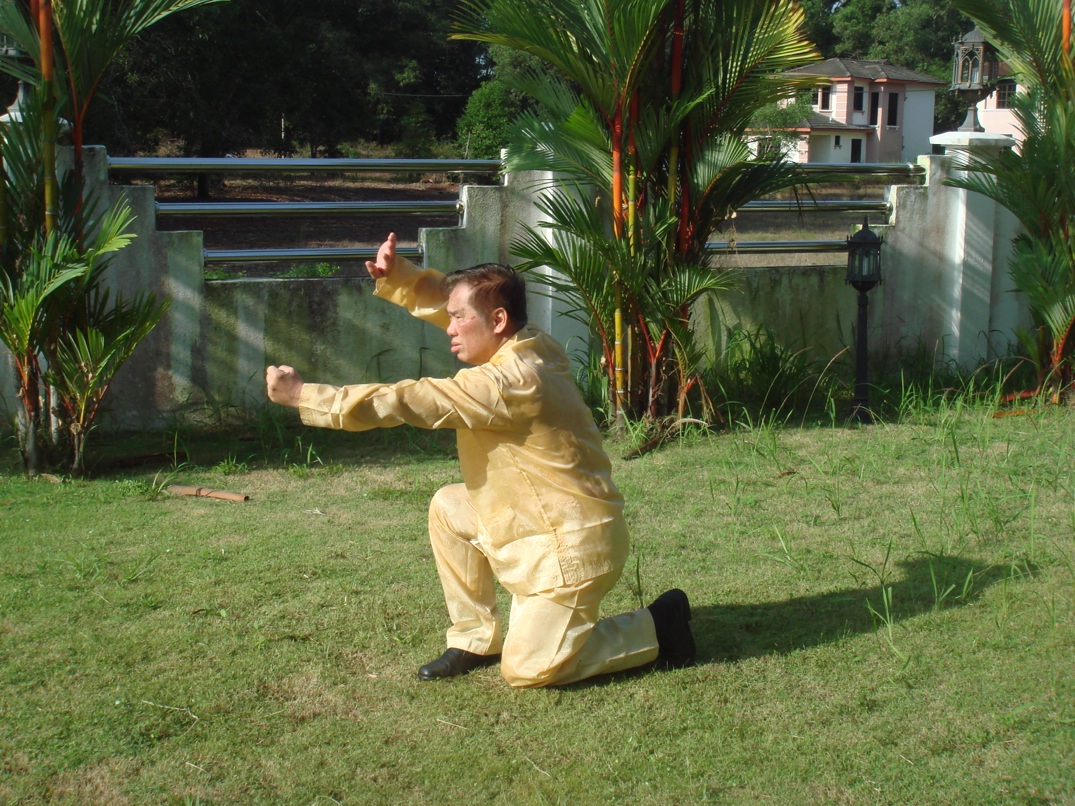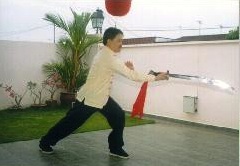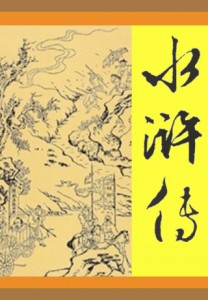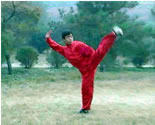SELECTION OF QUESTIONS AND ANSWERS
SEPTEMBER 2013 PART 2

"Crouching on Ground to Strike Tiger" of the Flower Set
Question 1
Sifu, was the way you taught in the past the same as the way you are teaching now? If not, what is the crucial difference?
— Sifu Barry Smale, UK
Answer
When I first set up Shaolin Wahnam Association in Sungai Petani in the early 1980s, I taught the way I was trained. The fundamental set where every student had to learn was Four Gates, followed by its application set. Then every student learned the fundamental weapon set, which was Chin Wah Staff.
After this, different students were taught different selective sets, such as Shaolin Pakua, Taming Tiger, Flower Set and Triple Stretch. Then they separately learned different weapon sets, such as Plum flower Sabre, Shaolin Sword, Thirteen-Technique Spear, Through-Cloud Umbrella, Crescent-Moon Spade and Crescent-Moon Guan Dao.
Meanwhile I also taught the 36 Specific Techniques to every student. This was usually done at the end of a training session and one specific technique was taught at a time, like how to defend against a middle kick or how to release a wrist lock.
I discovered that the Combat Application Set of Four Gates was too sophisticated for ordinary combat. So to enhance students' combat efficiency, I devised 12 Shaolin combat sequences, and taught them as a supplement.
The way I taught at Shaolin Wahnam Association for many years was quite different from the way I am teaching now. For convenience, the way I first taught may be called the orthodox way, which is also used by most other kungfu schools today. The other way may be called unorthodox, which derived much inspiration from how I learned from Sifu Ho Fatt Nam.
A crucial difference between the orthodox way and the unorthodox way is that the former focuses on forms, whereas the latter on force training and combat application. Ironically, as I discovered from research, the unorthodox way was actually the orthodox way how kungfu was practiced at the Shaolin Temple and by masters elsewhere in the past. It was only during the 20th century that the originally orthodox method became the unorthodox and that practicing only kungfu forms became the orthodox.
Question 2
When did you first begin to teach sets like Flower Set, etc?
Answer
I first taught sets like Flower Set, Taming Tiger and Triple Stretch in the 1980s. But the way I taught them was different from the way I teach them now. In my earlier method of teaching, I focused on picture-perfect form. Now I focus on force training and combat application, though picture-perfect form is still important.
My modern unorthodox way of teaching began in the late 1990s when I set up Shaolin Wahnam Institute (in contrast to Shaolin Wahnam Association) and taught overseas. First I taught the basic Shaolin 16 combat sequences, which were upgraded from the earlier 12 combat sequences. Later I added the basic Taijiquan 12 combat sequences.
It was from 2005 that I introduced selective sets, like Tiger-Crane, Dragon-Tiger, Dragon Form, Five Animals, Shaolin Pakua and Monkey Set. Except the Shaolin Pakua Set which is of medium length, and the Monkey Set which is long, the other sets are short, about 36 patterns each.
From about 2010, longer sets like Iron Wire, Triple Stretch and Flower Set were taught. Meanwhile, kungfu sets from other styles, like Tantui, Eagle Claw and Praying Mantis from Northern Shaolin, Swimming Dragon from Baguazhang, and 108-Pattern Yang Style Taijiquan, Flowing Water Floating Clouds and Wudang Taijiquan from Taijiquan were also introduced.
Starting at about 2000 where no classic sets were taught, since 2005 our school has become a treasure house where many famous classic sets can be learnt.

Goh Kok Hin, a senior disciple of Grandmaster Wong, performing the Plum Flower Single Sabre
Question 3
What was the rationale for introducing them (from no classic sets to a treasure house of classic sets) when you did?
Answer
The rationale for this interesting development from no classical sets to a treasure house of classical sets was to meet expedient needs.
When I first taught Shaolin Kungfu in our school, Shaolin Wahnam Institute, around the year 2000, I used sets invented by me instead of the many classical sets, because I found the classical sets too sophisticated for our students to effectively learn using them in free sparring. So I used the 16 combat sequences.
To be familiar with basic Shaolin patterns before attempting combat application, I used four basic striking patterns and their defence which form the set, Lohan Asks the Way. A set of four sequences from the 16 combat sequences, with each set focusing on a special theme, form the four sets, Black Tiger Steals Heart, Fierce Tiger Speeds through Valley, Happy Bird Hops up Branch and Fell Tree with Roots.
Except for the 24-Pattern Simplified Taijiquan Set, which is now called Cloud Hands Grasp Sparrow, the development of sets in Taijiquan followed the same rationale. The basic set was White Crane Flaps Wings. The 12 Taijiquan combat sequences form the sets, White Snake Shoots Venom, Green Dragon Shoots Pearl, Black Bear Sinks Hips, and Carry Tiger Back to Mountain.
Having established combat efficiency amongst our students, the next step was to enrich their techniques and skills in advanced combat. This was accomplished by introducing short sets but with a great variety of techniques, such as Tiger-Crane, Dragon-Tiger, Five Animals and Dragon Form. Shaolin Pakua Set and Monkey Set, which were longer, were added in response to requests from Anthony (Sifu Anthony Korahais) and Darryl (Sifu Darryl Collett).
Later to enable our students to appreciate the legacies of great past masters, their representative sets were introduced. Hence, Eight-Collection of Wang Lang, Siu Lin Tou of Yim Wing Choon, Choy-Li-Fatt Twelve-Fist of Chen Harng, Iron Wire of Tit Kiew Sam, Triple Stretch of Hoong Hei Khoon and Sam Tuck, Flower Set of Ng Mui, Swimming Dragon of Dong Hai Chuan, and Wudang Taijiquan of Zhang San Feng were taught in our school. And of course during the coming UK Summer Camp 2013 our students will have the opportunity to learn Five-Elemental Continuous Fist and Twelve-Animal Continuous Fist of Yue Fei.
Isn't our school a treasure house of kungfu legacies?
Question 4
As I understand it you taught Levels 1 - 12 of the Shaolin Wahnam Kung Fu training programme as the fundamentals for a number of years.
Answer
The Shaolin Kungfu Training Programme, which covers Level 1 to Level 12, is formulated with certain aims and objectives in mind. The general aims are to provide students with a basic understanding and practice of Shaolin Kungfu, and to contribute towards their good health, vitality, longevity, combat efficiency, mental freshness and spiritual joys irrespective of race, culture and religion.
The objectives, which gear towards realization of the general aims, are to provide a foundation for kungfu training, including some understanding of philosophy and history, to develop internal force, mental clarity and spiritual joys (like being relaxed, peaceful and happy), to be combat efficient against all the four categories of unarmed attack, and to be able to handle armed and multiple assailants.
To meet these objectives, Levels 1 and 2 provide the foundation, Levels 3 to 6 provide training in dealing with the four categories of unarmed attack, Level 7 provides training for a fundamental kungfu set that was practiced in the past at the southern Shaolin Temple, Levels 8 and 9 provide training in the staff and the sabre, which are basic weapons, Level 10 provides training in combat against weapon attacks, and Levels 11 and 12 provide training in combat against multiple unarmed and armed attacks.

"Water Margin", also known as "Outlaws of the Marches" is one of the most famous Chinese novels. This picture is reproduced from http://www.chinancient.com/page/18/
Question 5
Could you say something about the reasons/benefits for putting weapons training (Ho Family Flowing Water Staff set and the Plum Flower Single Sabre set) as Level 8 and 9 of the training programme?
Answer
In the Shaolin Kungfu Training Programme Ho Family Flowing Water Staff is placed as Level 8, and Plum flower Single Sabre as Level 9 because these placings in line with the other placings form a logical development of a Shaolin Kungfu practitioner, giving him the best benefits.
As a comprehensive training programme, besides unarmed combat our training includes self-defence against armed opponents, which is placed at Level 10. To be more effective against armed opponents, it is helpful first to learn the destructive properties of basic weapons. Thus the staff and the sabre are placed before Level 10 at Levels 8 and 9.
But before one can be effective against armed attacks, he should be competent in unarmed combat covering all the four categories of attack, and this is covered from Levels 3 to 6, followed by practice of a classical kungfu set at Level 7 which sums up and progresses from the training of unarmed combat.
To be able to engage in combat efficiently, students should have a sound foundation, which also includes basic philosophy and history, and these are covered in Levels 1 and 2.
Hence, the programme from Level 1 to Level 12 provides systematic and progressive training for students starting from scratch to a stage where they are combat efficient not only in unarmed combat but also against weapon and multiple attacks. Placing Ho Family Flowing Water Staff and Plum flower Single Sabre at Levels 8 and 9 fits in well in this arrangement.
Question 6
I hope Sifu won't mind if I share some interesting experiences I have lately. I don't hold on to the experiences, but they keep on happening. Outside of practice also, I can feel it inside of me. It all comes from my heart, it is inside of me, that's how it feels.
When a certain sequence I never learnt comes out, I am that sequence, like I have practiced it forever. Much of it I can do outside of chi flow also, like when enjoying tea, or a few beers, or just the energy that comes up when listening to my favourite music.
Name and Country Withheld
Answer
This is wonderful. It is the mark of a master. It is probably due to attainments in your past lives.
Editorial Note
: Tim's other questions will can be found at
September 2013 Part 1
issue of the Question-Answer Serie

Chuo Jiao Kungfu is known for its extensive kicking techniques. This picture is reproduced from http://www.damo-qigong.net/kungfu/cuojiao/cuo_jiao_boxing.htm
Question 7
In chi flow I continue to talk Chinese. I can actually speak sentences outside of my chi flow because it happens so much.
I have seen a documentary about Chuo Jiao Kungfu on YouTube, and I speak the same type of dialect they spoke in that video. I believe it is Mandarin, from Beijing.
It is very interesting because when watching the documentary, it dawned on me that I sometimes do very similar movements of Chuo Jiao in chi flow. The kicking and striking, and the poise pattern. Some of the punching feels like "snapping", like the fist snaps out fast to the opponent with internal force.
From my small understanding, experiencing this, I can't help but notice the similarities between Eagle Claw, Xing Yi and Chuo Jiao. They are different but feel as they come from the same source.
Answer
As I have mentioned earlier, and other people may think I have gone crazy, you are probably a reincarnation of the Song Dynasty kungfu master, Wu Song, one of the 108 heroes of the Water Margin legend. Wu Song was an expert in Chuojiao Fanziquan, a northern Shaolin style which uses kicks extensively.
Chuo Jiao, Eagle Claw and Xing Yi are closely related. The first patriarch of Chuo Jiao Kungfu taught Zhou Tong, who taught Yue Fei. Yue Fei invented Eagle Claw and Xing yi Kungfu.
Question 8
I am reading a book, "Outlaws of the Marches", and have been thinking about what you told me about Wu Song. I am definitely doing a style where I am being handcuffed in chi flow. The kicking that goes on is fierce and powerful, and with a lot of skills. I never knew I had this in me.
I have to say there are similarities in Wu Song's life and mine. One thing that returns is girls who are already dating that show interest in me. Of course I don't steal people's girlfriends. Also I feel very strong when drinking.
When I was 16 years old, I stood up for a friend who was getting laughed at once again, and I had enough of it. This person was 2 heads bigger then me, (I was then even smaller then I am now), and I just pushed him and he flew meters away. His 5 friends went to fight with me, and one of them hit me at the back of my head.
This made me so angry that I took out the largest guy of the group, and it felt like I was flying in the air towards him, with a series of straight forward punches he again flew meters back ending on the ground, much to my and everyone's surprise.
Luckily, my other friends went to stop the fight, and we all ended up shaking hands. But this has always left me quite surprised.
A similar thing happened as a child, but I don't remember what happened, only that I beat the bully.
I also have the bad habit of not knowing when to stop drinking which results in me going into a rage sometimes, and which I am not proud of.
Answer
Such behaviour was characteristic of Wu Song who was small-sized like you. Wu Song, like all great kungfu masters, was well known for "kin ye yong wei" which literally means "see righteousness courageously act" which is "act courageously when you see occasions to right wrongs". I am proud of you.
Wu Song drank three big bowls of strong liquor and went up a mountain to kill a fierce tiger.
After killing a bully, Jiang Men Shen, Wu Song was exiled. But the guards who escorted him were bribed to kill him. He broke his handcuff and killed the guards. After that he ascended Mount Liang to become an outlaw being one of the 108 outlaws of the Water Margin legend.
A hallmark of Wu Song was his honouring women who were already married or engaged. Even when they flirted with him, he would avoid them.
LINKS
Selected Reading
- On God, Buddha and Immortals
- The Chameleon
- Shaolin Eighteen Lohan Hands
- Combat Applications of Taijiquan
- Great Benefits
